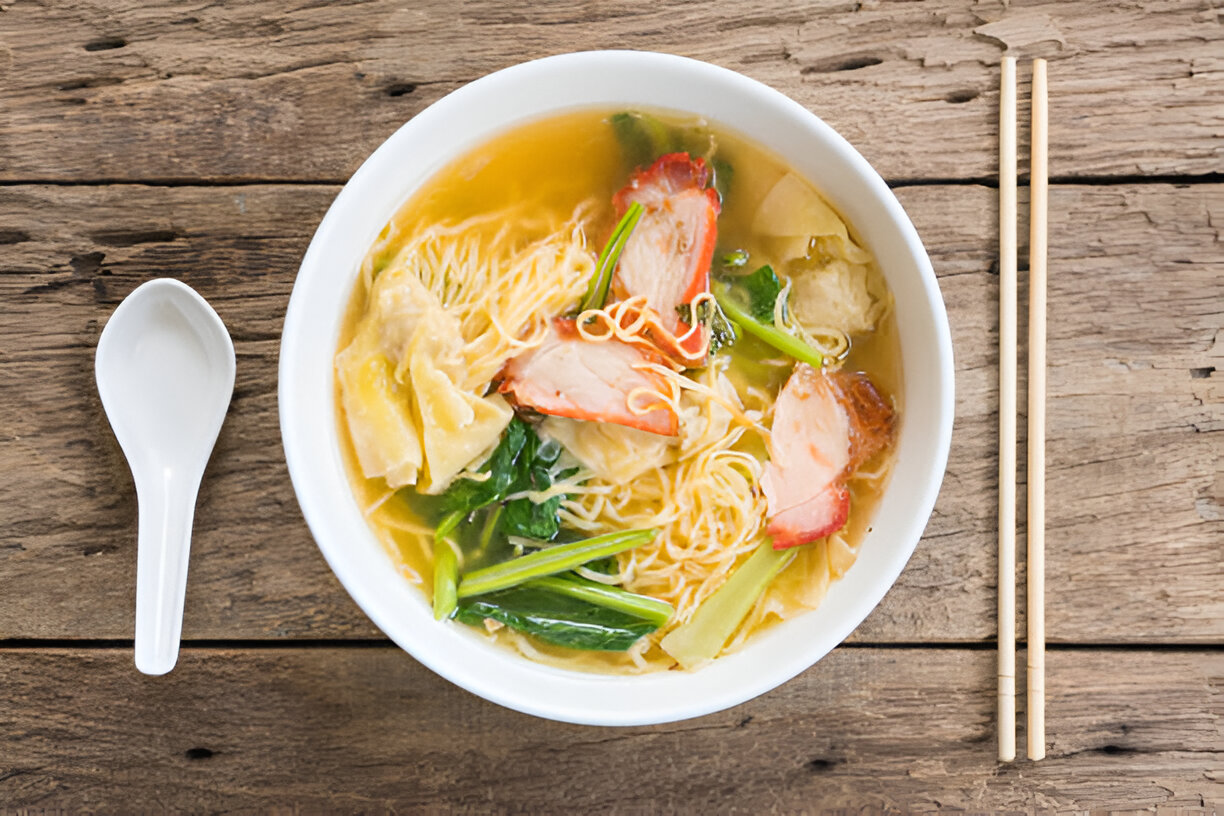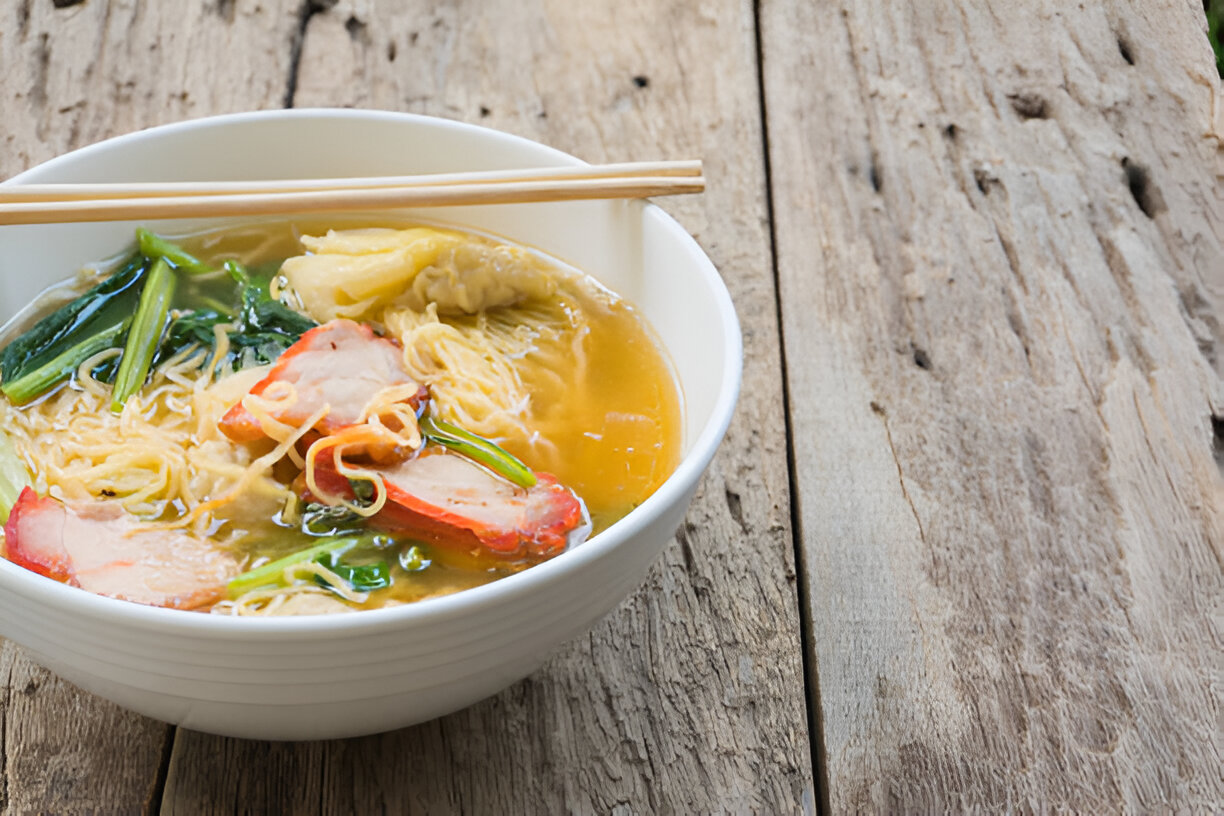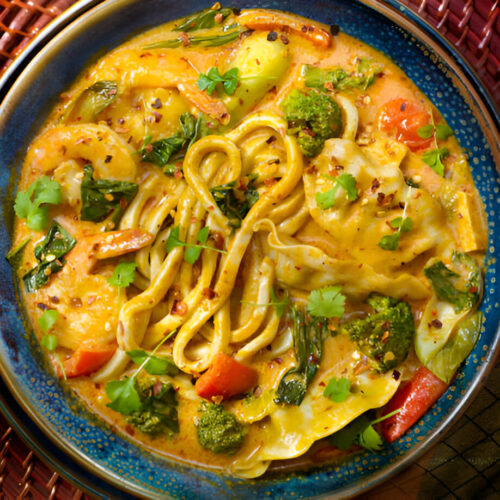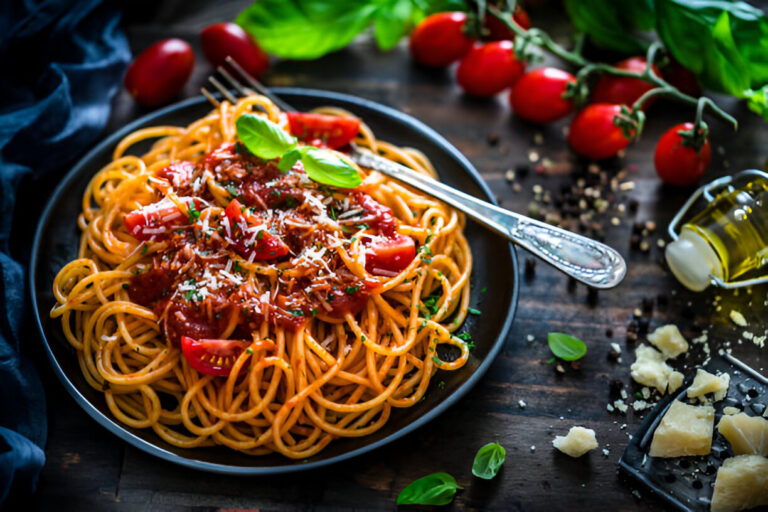Thai Red Curry Dumpling Soup: Flavorful Recipe & Tips
Thai cuisine is celebrated around the world for its vibrant flavors, aromatic spices, and diverse textures. From fragrant curries to refreshing salads, the versatility of Thai food captivates both the palate and the senses. One such dish that exemplifies this culinary art is Thai Red Curry Dumpling Soup, a savory and comforting creation that combines the beloved elements of traditional Thai preparation with the delightful experience of dumplings. This soup stands out as it not only offers the rich and complex flavors of red curry but also presents a delightful fusion of textures from tender dumplings swimming in a creamy coconut broth.
What makes Thai Red Curry Dumpling Soup truly unique is its harmonious blend of ingredients that come together to create a balance between spice, creaminess, and freshness. Each spoonful bursts with flavors, transporting you to the vibrant streets of Thailand, where street food and culinary craftsmanship abound. The combination of the luscious coconut milk and aromatic red curry paste envelops the dumplings—whether stuffed with succulent proteins like chicken or shrimp, or the heartiness of tofu—adding layers of depth to each bite.
Moreover, this dish provides various health benefits, making it a wholesome choice for any meal. Packed with nutrients from fresh vegetables and herbs, along with the unique properties of ginger and garlic, Thai Red Curry Dumpling Soup is not only delicious but also nourishing. Whether you are looking for comfort on a chilly day or a quick, satisfying meal, this soup caters to all cravings while offering an opportunity to enjoy the iconic flavors that define Thai cuisine.

What is Thai Red Curry Dumpling Soup?
Thai Red Curry Dumpling Soup is a delightful culinary creation that marries the essence of Thai cuisine with the comforting nature of soup. This dish features tender dumplings—often filled with an assortment of proteins such as chicken, shrimp, or tofu—that are simmered in a rich, creamy coconut broth infused with the vibrant flavors of red curry. The result is a soup that is both satisfying and packed with aromatic flavors, embodying the essence of Thai street food culture.
The origins of this dish can be traced back to Thailand’s rich culinary traditions, where bold flavors and fresh ingredients are paramount. In Thai cuisine, the use of curry pastes is a commonplace practice, showcasing a diverse array of herbs and spices that not only add flavor but also reflect the region’s agricultural bounty. Dumpling soups have long been celebrated in various Asian cultures, making Thai Red Curry Dumpling Soup a unique fusion that highlights the distinct tastes of Thailand while incorporating beloved elements from other culinary traditions.
The main ingredients that define this dish include Thai red curry paste, coconut milk, and an assortment of fillings for the dumplings. The red curry paste usually consists of ingredients such as chili, garlic, lemongrass, and kaffir lime leaves, resulting in a flavor profile that is at once spicy, fragrant, and slightly sweet. When combined with creamy coconut milk, these flavors create a soothing yet exhilarating broth perfect for any occasion.
Key Ingredients in Thai Red Curry Dumpling Soup
The heart of Thai Red Curry Dumpling Soup lies in its ingredients. Each component plays a crucial role in building the flavor and texture that make this dish so special.
2.1 Dumpling Ingredients
- Dumpling Wrappers: Commonly used wrappers include wonton wrappers or rice paper, both of which provide a versatile base for filling.
- Protein Options: The dumplings can be filled with a variety of proteins such as diced chicken, succulent shrimp, or for a vegetarian alternative, tofu.
- Seasoning and Aromatic Components: Ingredients like minced garlic, ginger, and fresh herbs contribute aromatic qualities that enhance the filling.
2.2 Soup Base Ingredients
- Thai Red Curry Paste: Look for high-quality curry paste made from fresh ingredients, as this forms the backbone of the soup’s flavor.
- Coconut Milk: The richness of coconut milk balances the spice of the red curry; opt for full-fat coconut milk for a creamier texture.
- Broth Options: Depending on dietary preferences, you can choose from vegetable, chicken, or seafood broth as the base of the soup.
2.3 Additional Flavor Enhancers
- Fresh Herbs: Adding fresh basil and cilantro brightens the soup and enhances its authentic Thai flavor.
- Vegetables: Incorporate seasonal vegetables like bell peppers, mushrooms, or green onions for added nutrition and texture.
- Optional Garnishes: For a final touch, serve the soup with lime wedges or a drizzle of chili oil to amp up the flavor.

3. Health Benefits of Thai Red Curry Dumpling Soup
Thai Red Curry Dumpling Soup is not only a delight for the taste buds but also a nutritious addition to your diet. This dish’s intricate blend of ingredients comes with various health benefits, making it a wholesome choice for any meal.
One of the key components of this soup is curry, particularly the red curry paste. Ingredients like chili peppers used in the paste are known for their metabolism-boosting properties, aiding in weight management and promoting fat loss. Moreover, the vibrant colors of the vegetables incorporated into the soup signal a wealth of vitamins and minerals that are vital for overall health.
Coconut milk, while rich in fats, contains medium-chain triglycerides (MCTs), which can be a quick source of energy and might help with fat loss when consumed in moderation. The creamy base not only contributes to a rich texture but also provides essential nutrients such as iron, potassium, and vitamin C.
Fresh herbs like basil and cilantro are not just for garnishing; they are packed with antioxidants and essential oils known to boost immune function and improve digestion. The inclusion of garlic and ginger not only enhances the flavor but also carries anti-inflammatory and anti-bacterial properties, contributing to improved health.
For those with dietary restrictions, Thai Red Curry Dumpling Soup is highly versatile. It can be made gluten-free by using rice paper for dumplings and ensuring that no soy sauce or gluten-containing ingredients are introduced. Additionally, individuals looking for a vegan option can easily replace protein with plant-based alternatives without losing the dish’s essence.
4. How to Make Thai Red Curry Dumpling Soup: A Step-by-Step Guide
4.1 Preparation of Ingredients
Before diving into the cooking process, it’s essential to prepare all ingredients for an efficient cooking experience. Start by chopping fresh vegetables like bell peppers, carrots, and mushrooms into bite-sized pieces. This ensures they cook evenly and absorb the soup’s flavors.
Next, focus on making the dumplings. Use wonton wrappers or rice paper, depending on your preference. If you are using wonton wrappers, you can cut them into the desired shapes. For a more delicate option, rice paper can be softened in warm water before wrapping. Prepare your filling mixture by combining diced protein with minced garlic, ginger, and a pinch of salt.
4.2 Cooking the Soup Base
To create the soup base, start by heating your chosen broth—vegetable, chicken, or seafood—in a large pot over medium heat. Once it begins to simmer, pour in the creamy coconut milk and stir in the Thai red curry paste. It’s crucial to select a high-quality curry paste, as it significantly impacts the flavor of the soup. Allow the mixture to simmer gently, letting the flavors meld. If needed, taste and adjust the spice levels according to your preference.
4.3 Cooking the Dumplings
Once your soup base is ready, it’s time to cook the dumplings. Gently add them to the simmering broth. If they are fresh, they usually take about 5 to 7 minutes to cook through. You’ll know they are done when they float to the surface and are opaque. For frozen dumplings, allow a few extra minutes for cooking.
4.4 Combining Soup and Dumplings
After the dumplings are cooked to perfection, add in your chopped vegetables and let them simmer for an additional 2 to 3 minutes until tender. This makes sure that the vegetables retain their nutrition while still soaking up the broth’s flavors. To serve, ladle the piping-hot soup into bowls, ensuring each serving has an abundance of dumplings and vegetables. Garnish with fresh herbs and offer lime wedges or chili oil on the side to enhance the experience.
5. Tips and Tricks for Success
While preparing Thai Red Curry Dumpling Soup, several tips can help avoid common pitfalls and ensure a delightful outcome. One of the biggest mistakes is overfilling the dumplings, leading to difficulty sealing them properly. Keep the filling to about a teaspoon per wrapper to prevent breakage during cooking.
When selecting your ingredients, always opt for fresh produce, particularly for the vegetables and herbs, as they significantly enhance the dish’s flavor. If you’re not sure about the spice level, start with a smaller amount of red curry paste and add more as it simmers—this approach allows you to adjust based on your preference.
For pairing, consider serving the soup alongside a light salad, such as a Thai cucumber salad or spring rolls, which complement the richness of the soup. When it comes to beverage pairings, a chilled Thai iced tea or a refreshing coconut water can cleanse your palate beautifully.
For storage, keep any leftover soup in an airtight container in the refrigerator for up to three days. To reheat, gently warm on the stovetop, being cautious not to overcook the dumplings. You may need to add a splash of broth or coconut milk to restore its creaminess.
6. Variations of Thai Red Curry Dumpling Soup
6.1 Different Proteins
Exploring different proteins can add a unique twist to your Thai Red Curry Dumpling Soup. Apart from options like chicken, shrimp, and tofu, consider using beef or fish for distinct flavors. Beef dumplings provide a hearty texture, while fish can offer a lighter, flaky alternative. Experimenting with plant-based proteins like lentils or chickpeas can also elevate the dish while catering to vegan diets.
6.2 Spicing it Up
If you enjoy heat, there are several ways to amp up the spice level of your soup. Incorporate fresh or dried chilies during cooking, or use additional chili paste for more kick. Adjusting the amount of red curry paste will also affect the heat, allowing you to customize your soup to your liking.
6.3 Seasonal Additions
Seasonal vegetables can enhance the nutrition and taste of Thai Red Curry Dumpling Soup. In the summer, zucchini and corn can add freshness, while winter can call for hearty greens like kale or spinach. Feel free to adapt the vegetable contents based on what is available, ensuring you always have a vibrant medley.
7. FAQs About Thai Red Curry Dumpling Soup
What is the difference between red curry and green curry?
Red curry is typically made with red chilies, offering a richer and deeper flavor profile, while green curry incorporates green chilies, resulting in a fresher, more herbal taste. The choice often depends on personal preferences and desired spice levels.
Can I make this soup vegan?
Absolutely! By using vegetable broth, coconut milk, and plant-based proteins like tofu or mushrooms, you can easily create a delicious vegan version of Thai Red Curry Dumpling Soup.
How can I make dumplings ahead of time?
Dumplings can be prepared in advance and frozen. After assembling them, lay them on a baking sheet lined with parchment paper and freeze until solid. Once frozen, you can transfer them to a resealable bag and store them for future use. They can be cooked directly from frozen, adding a few extra minutes to the cooking time.
What if I don’t have red curry paste?
If red curry paste is not available, you can substitute it with a mixture of equal parts curry powder and fresh chilies, adjusting to taste. Alternatively, consider using other curry pastes like green or yellow, although it will change the overall flavor profile of the soup.

Thai Red Curry Dumpling Soup
Equipment
- 1 large pot
- 1 mixing bowl
- 1 spoon or spatula
- 1 whisk
- 1 rolling pin
- 1 cutting board
- 1 cooking thermometer optional
Ingredients
- 1 tablespoon vegetable oil
- 1 medium onion, diced
- 3 cloves garlic, minced
- 1 tablespoon fresh ginger, minced
- 2 tablespoons red curry paste Adjust spiciness based on preference.
- 4 cups chicken or vegetable broth
- 1 can (14 oz) coconut milk
- 1 tablespoon fish sauce (or soy sauce for vegetarian option)
- 1 tablespoon lime juice
- 1 cup mushrooms, sliced
- 1 medium bell pepper, diced
- 2 cups spinach or bok choy, chopped
- to taste fresh cilantro, for garnish
- 1 cup all-purpose flour (for dumplings)
- ½ cup water (for dumplings)
- ¼ teaspoon salt (for dumplings)
- filling of your choice e.g., minced chicken, shrimp, or vegetables For a vegetarian option, use a mix of vegetables like cabbage, carrots, and tofu.
Instructions
- In a mixing bowl, combine the flour and salt. Gradually add water while mixing until a soft dough forms. Knead for 5 minutes, then cover and let it rest for 15 minutes.
- Prepare your filling of choice by mixing the ingredients in a bowl. Set aside.
- Roll the dough out on a lightly floured surface to about 1/8-inch thickness. Cut out circles using a cookie cutter or glass.
- Place a small spoonful of filling in the center of each circle. Fold the dough over to create a half-moon shape and pinch the edges to seal. Set aside.
- In a large pot, heat the vegetable oil over medium heat. Add the diced onion and sauté for 3-4 minutes until translucent.
- Add the minced garlic and ginger, cooking for an additional minute until fragrant.
- Stir in the red curry paste, cooking for 1-2 minutes to bloom the spices.
- Pour in the chicken or vegetable broth and coconut milk. Bring to a gentle simmer.
- Add the fish sauce (or soy sauce), lime juice, mushrooms, and bell pepper to the pot. Let simmer for 10 minutes until vegetables are tender.
- Gently add the dumplings to the soup, cooking for an additional 8-10 minutes until they float to the surface and are cooked through.
- Stir in the chopped spinach or bok choy and cook for another 2 minutes until wilted.
- Ladle the soup into bowls and garnish with fresh cilantro. Serve hot.







